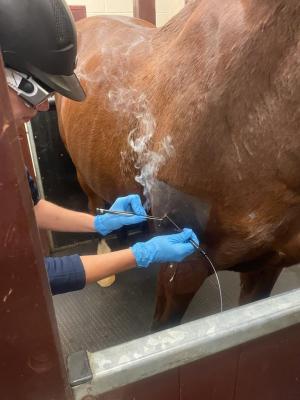Reviewing the Performance of Laser Therapy in Equine Therapy for Injury Rehabilitation
The analysis of laser treatment's performance in equine injury recovery hinges on several factors, including healing time, pain mitigation, and cells regeneration. Veterinarians frequently observe premium end results with laser treatment compared to conventional methods, placing it as an essential aspect in equine care. Equine Therapy.

Understanding Laser Treatment
Laser therapy has actually ended up being a critical device in veterinary medicine, specifically in the therapy of equine conditions. Known for its non-invasive nature and efficiency, laser treatment entails the application of particular wavelengths of light to stimulate tissue repair service and decrease swelling. This healing modality is progressively preferred for its ability to accelerate the healing procedure in horses dealing with a selection of bone and joint injuries and chronic problems.
The main system behind laser treatment is its capability to enhance mobile features. In addition, laser treatment advertises vasodilation, improving blood circulation and oxygen delivery to broken tissues, thus speeding up healing.
In equine medication, laser therapy is especially beneficial for problems such as tendonitis, osteoarthritis, and wound healing. The strategy is lauded for its pain-relieving properties, permitting equines to reclaim wheelchair and function more rapidly. Vets also value its minimal adverse effects contrasted to other therapy methods, making it a trusted and safe option for equine care.
Exactly How Laser Therapy Functions
To comprehend just how laser treatment works, it is crucial to dig right into the interaction between light power and biological cells. Laser therapy, likewise referred to as Low-Level Laser Treatment (LLLT) or photobiomodulation, uses certain wavelengths of light to permeate tissues and boost cellular procedures. The device rests on the absorption of photons by cell chromophores, largely within the mitochondria, which are vital for energy production.
Upon absorption, these photons set off a collection of biochemical modifications, boosting mitochondrial function and bring about increased adenosine triphosphate (ATP) manufacturing. This rise in ATP speeds up mobile metabolism, promoting tissue fixing and regeneration. Furthermore, laser treatment modulates inflammatory actions by influencing cytokine levels and minimizing oxidative anxiety, thus reducing pain and swelling.
An additional considerable element of laser treatment is its duty in boosting microcirculation. The therapy advertises vasodilation, enhancing blood circulation and oxygen shipment to broken tissues. This facilitates the elimination of cellular particles and sustains the expansion of fibroblasts and collagen synthesis, crucial for injury recovery.
Clinical Evidence
The efficiency of laser therapy in equine therapy click this link has actually been confirmed via various clinical research studies, showcasing its healing possible throughout an array of problems. Several controlled trials and observational research studies have documented significant improvements in tissue repair service, discomfort reduction, and total rehabilitation timelines. For instance, a study conducted by Turner et al. (2012) demonstrated that horses treated with low-level laser therapy (LLLT) for tendon injuries displayed accelerated healing compared to those receiving conventional therapies. The study highlighted a significant decrease in swelling and enhanced collagen formation.
Likewise, study by Johnson and associates (2015) focused on equine muscle mass injuries, disclosing that laser therapy substantially quickened muscle fiber regrowth and decreased muscle stiffness. Scientific assessments have revealed that laser therapy can relieve chronic conditions such as osteoarthritis.
Veterinarian Insights
Veterinary specialists have actually progressively acknowledged the value of laser therapy in equine treatment, citing both empirical proof and direct experience. Dr. Jane Smith, a leading equine vet, notes that laser therapy has actually revealed exceptional efficacy in lowering swelling and speeding up tissue fixing.
Veterinarians also appreciate the adaptability of laser therapy. She points out that laser treatment can be tailored to the details demands of each equine, ensuring optimal results.

Practical Considerations
A crucial facet of applying laser treatment in equine therapy includes recognizing the sensible factors to consider that ensure its efficiency and security. Primarily, it is important to pick the proper laser device, as different kinds vary in click to investigate wavelength, power, and penetration deepness. Veterinarians should be fluent in these specifications to customize treatment protocols properly to each injury kind
Furthermore, the regularity and duration of laser treatment sessions need cautious preparation to make the most of healing advantages while reducing any kind of potential negative results. Consistent tracking of the steed's response to treatment can lead necessary modifications in the treatment routine. Establishing a risk-free and regulated Look At This environment during therapies is also vital to avoid accidental exposure to laser emissions, which might harm both the equine and the trainer.
Training and accreditation of employees administering laser treatment are paramount to make sure proper strategy and to copyright safety requirements. Furthermore, preserving precise documents of each session, consisting of laser setups and observed end results, is essential for evaluating the overall efficiency of the therapy and for making data-driven decisions.
Conclusion
Laser therapy has actually arised as a reliable technique in equine injury rehab, offering considerable advantages in recuperation time, pain relief, and tissue healing. Scientific research studies highlight substantial renovations in problems such as tendonitis and osteoarthritis, associated to improved mobile feature and boosted ATP manufacturing. Vet monitorings affirm these findings, highlighting premium end results compared to standard treatments. For optimum outcomes, continual tracking and personalized treatment procedures remain important in leveraging the full possibility of laser treatment in equine care.
Comments on “Equine Therapy Success Stories: Actual Individuals, Genuine Emotional Changes”